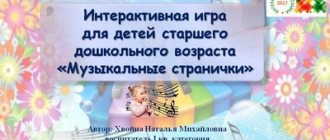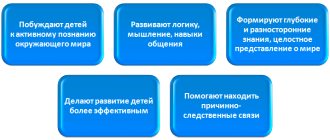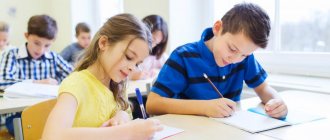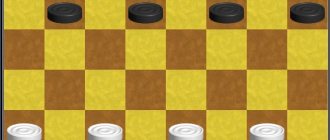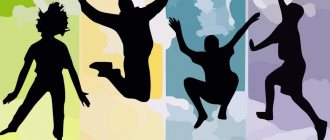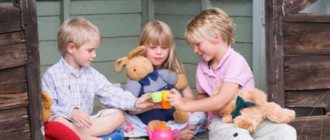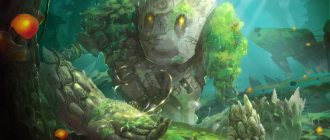MAGAZINE Preschooler.RF
“LET’S DISCOVER THE MUSIC IN YOURSELF: creative research PROJECT “EVERYONE CAN BECOME A MUSICIAN!”for children of senior preschool age
STATE BUDGETARY EDUCATIONAL INSTITUTION OF THE SAMARA REGION SECONDARY SCHOOL VILLAGE. PROSVET (GBOU SOSH village Prosvet) VOLZHSKY DISTRICT OF SAMARA REGION – STRUCTURAL DIVISION “KINDERGARTEN “MISHUTKA”
The project was prepared and implemented by: music director Svetlana Ivanovna Adut. Roshchinsky 2016
BRIEF DESCRIPTION OF THE PROJECT
The project is aimed at developing the musical abilities of preschool children. The project promotes the development of communication, encourages children to make discoveries and original self-expression in everyday life.
PROJECT TYPE:
- By number of participants – group
- Focus: research, creative
- Duration: short-term
PROJECT PARTICIPANTS:
- children of senior group No. 5;
- musical director;
- educators;
- parents.
DURATION: 6 weeks (July 15 – August 26, 2016)
RELEVANCE:
Musical instruments attract children's attention very much, and they want to play themselves. Children learn about the world through play, and that is why the task of organizing independent children's play activities is so urgent today.
Recently, observing children in groups, I noticed that independent musical activity has lost its novelty, children practically do not play musical instruments in groups - for them they have become ordinary, familiar, and therefore boring. It was necessary to attract children's attention to this type of activity, and for this purpose, to update and replenish the musical corners with new homemade musical and noise instruments and thus create conditions for active experimentation with sounds in order to accumulate initial musical experience.
Our ideas about the world around us are largely formed as a result of our own experience. Likewise, musical and auditory perceptions are individual in nature and depend on personal musical experience. Children's exploration of sound will help the child understand through his own touch what the sound of hitting, stroking, shaking objects can be. This is very important for the development of musical ear.
By experimenting with sounds, the child will begin to perceive the world around him differently, learn to understand the properties and quality of sounds, select a soundtrack to convey an image, and will be able to use the acquired knowledge in improvisation on children's musical and noise instruments, developing his creative abilities.
OBJECTIVE OF THE PROJECT:
- Develop musical and creative abilities based on the integration of different types of artistic and aesthetic activities through the creation of homemade musical instruments in partnership between adults and children;
- To increase children's interest in sounding objects and instruments through exercises, games, and fairy tales;
- Involve parents in joint musical and gaming activities.
PROJECT OBJECTIVES:
- Expand children's horizons through familiarization with noise and musical instruments;
- Encourage children to experiment with sound in order to establish the dependence of sound quality on the properties of the materials used. To develop children's ear for music, musical abilities (sense of rhythm, mode, tempo, pitch, harmonic, timbre hearing), tactile sensations;
- To promote the creation of conditions for the child’s creative self-expression in various types of artistic and aesthetic activities, taking into account his individual capabilities.
- Support children's initiative and desire to improvise when playing homemade toy instruments.
- Cultivate curiosity and interest in musical activities,
the ability to interact in collective music-making.
EXPECTED RESULT:
As a result of the project:
- Children will get acquainted with wooden, rustling, glass sounds, learn to play music and improvise on homemade instruments.
- Children will develop an interest in independent musical and playful activities, and their communication skills will develop: the ability to get along and negotiate with each other.
- Children will learn to experiment with sounds and develop an interest in discovery and original self-expression in everyday life.
EDUCATIONAL AREAS OF PROJECT IMPLEMENTATION:
- “Artistic and aesthetic development”;
- "Social and communicative development";
- "Cognitive Development";
- "Speech development";
- "Physical development".
MAIN FORMS OF PROJECT ORGANIZATION:
Conversation, children's experimental activities, classes, making musical instruments with your own hands, consultation for parents.
PRODUCT OF JOINT ACTIVITY BY CHILDREN:
- Mini-exhibition of children's musical instruments, made by hand from waste material, created together with parents, teachers and music director;
- Musical entertainment “Let's discover the music within ourselves” with the participation of children and parents.
PROJECT ORGANIZATION:
Creating conditions for active independent musical activity of children in groups; individual and group work with children; organization of conversations and joint musical play activities of the music director and teacher with students.
PROJECT SUPPORT
Logistics:
- Music Center;
- Children's musical instruments;
- Experiment kits:
- cups (plastic, wooden, metal and glass), spoon;
- children's guitar and ruler;
- candy wrappers, pebbles, coins, beads.
Interactive kit:
- Presentation “Ocean-sea blue”
- Presentation . ”
Didactic material:
- Musical and didactic games:
- “Seven-flowered flower” (Children are asked to use noise instruments to depict the sound of thunder, rain, rustling leaves, the sound of a hammer, a drum, the sound of a sea wave, the creaking of snow (other options can be used).
- “Orchestra” (You need to run in a circle to the music, and when it ends, take only musical instruments (or only noise instruments).
- “Loud and quiet bells” (improvisation on musical instruments)
- “What is extra” (Children are given cards. They must determine which type of activity on the card is extra, that is, different from the other two on the card).
- "Musical and noise sounds"
- Music games:
- “What does it sound like?” (The music director invites the children to close their eyes, and he plays phonograms of sounds: sea, wind, rain, clock striking, birdsong. Children guess what sounds.)
- “One, two, three, four, five - we’re going to look for sounds.”
Plastic, wood, metal and glass.
(Children walk around the hall, look for various sounds, talk about them)
3. "Drummers"
4. "Find your instrument"
5. “Clap-slap” musical-motor game
6. “Who went out for a walk” musical-motor game (Children are divided into 4 groups. Each occupies its own house - a bear, a fox, a bunny, a wolf. Each corresponds to music of different registers. Whose music sounds, moves around the hall in accordance with the image ( motor improvisation)).
- Songs:
- “Merry notes” (Yu Chichkov, Y. Khaletsky)
- “Merry musicians” (b.n.m., lyrics by G. Oleinik)
- “The Good Master” by I. Kostina
- “Hymn to Music” A. Ermolov, S. Pärnyanen
- “The sun is shining for everyone” A. Ermolov, V. Orlov
- Classical music:
- E. Grieg “Morning”
- R. Schumann “Trout”
- M.P. Mussorgsky “Overture from the opera “Sadko”
- V.A. Mozart "Bells" from the opera "The Magic Flute"
- F. J. Gossec "Gavotte"
- P.I. Tchaikovsky "March of the Wooden Soldiers"
- Illustrative material: image of children's noise musical instruments.
| Next > |
Short-term music project “Country of Kukland”
Short term music project
"Country of Kukland"
MDOU "Novokruchinsky kindergarten "Rostok"
Musical director: Selezneva Valentina Ilyinichna
2017
Short-term music project “Country of Kukland”
"Dance music "
is a program that enhances, predetermines the movement and play of each child.
J. J. Nover
Project type
:
short-term
, creative and informational.
Duration: 30 minutes.
Project participants
: middle group children, music director, teacher.
Relevance:
The interaction of society with music and movement shapes the improvement of musical and rhythmic movements in children.
Target:
Teach children musical and rhythmic movements, take into account the level of physical and aesthetic development.
Tasks:
1. Learn to convey a musical image in plastic, using various types of dance movements.
2. Develop an ear for music, creative freedom, and the ability to coordinate movements with music.
3. Strengthen the ability to independently rearrange in space (become scattered, in a common circle, observing intervals)
.
4. Train the child’s auditory and visual attention and voluntary movements.
5. Develop communication skills and the ability to cooperate in a group.
6. Increase the physical activity of children in class for the purpose of prevention.
Equipment:
Music Center
,
musical instruments
, movement patterns, cap.
Musical material
:
1. T. Suvorova. "Dance baby"
,
"Rhythmics for Children"
.
2. K. Novoskoltseva, I. Kaplunova. " Music and Miracles "
.
3. I. Matvienko “ Doll Masha ”
(gr.
“Ivanushki”
).
Expected result:
Children's knowledge of musical and rhythmic movements is consolidated;
Children learn to work with visual material and navigate in space.
Forms of working with children:
1. Introductory part (greeting)
2. Main part ( conversation :
“Favorite toys”
).
3. Musical and speech game “The locomotive is coming, going”
.
4. Rhythm game “Clock”
.
5. Rhythmic gymnastics to relax muscles “Bugs”
.
6. Draw a toy ( musical-rhythmic game )
.
7. Final part “Blue Car”
.
Tasks:
Creating an emotional mood. Activation of children.
Maintain mental performance, provide short-term rest.
Change of activity. Restoration of the nervous system, improvement of visual memory
Prevention of fatigue. Cultivate a love of toys, caring and goodwill. To develop in children the ability to repeat musical and rhythmic movements.
Introductory part
The song “ Doll Masha ”
performed by the group
"Ivanushki"
. Children from the middle group enter the hall.
Main part
Musical director
: Do you guys like to play? What do you need for this?
Children's answers: (toys)
.
Musical director
: Girls love to play with dolls.
What toys do boys like to play with?
Children's answers: (into cars)
.
Musical director
: But there are not only
dolls and cars
, but also other toys. Let's see what toys you drew.
(look at the drawings)
.
Both children and adults love toys, children play with them, and adults collect them.
It is absolutely impossible to live without toys.
I invite you to a magical land
, where toys live, and the
country “ Kukland ”
.
Attention, attention, the toy train is leaving, everyone takes their seats (children build a circle)
.
One, two, three, four five, we begin to count.
We begin to count and choose a driver.
One, two, three, you will be the driver.
So they chose the driver. And so that everyone knows that he is a driver, let’s put a cap on him
(children stand one after another)
.
Musical director
:
We are standing on the platform, waiting for our cars, the driver, hurry up, take us faster.
(performed by the musical and rhythmic composition “The locomotive is riding, the locomotive is riding”
). T. Suvorova.
Musical director
:
There is a magic clock hanging on the main square of the toy town. The clock did not break for a long time, it kept ticking and ticking until the mice tore off the weights.
There was a clock hanging on the wall (clapping for every syllable)
Tick-tock, tick-tock, (wooden sticks)
The cockroaches ate the arrows (clapping for each syllable)
.
Crum-tack, crunch-tack (wooden sticks, triangle)
.
The mice tore off the weights and clap for each syllable).
Bom-bom, bom-bom (triangle, maracas)
.
And the clock stopped ticking (clapping for every syllable)
.
Ding-dong, ding-dong (triangle, maracas)
.
Musical director
:
Let's try to wind our clock (children line up in a checkerboard pattern)
.
Game gymnastics “Clock”
Musical director
:
The clock started working, and all the toys in the doll country began to come to life and move.
(children improvise)
.
Musical director
:
He is with a bell in his hand, wearing a blue red cap.
He is a funny toy, and his name is... (parsley)
.
Gray flannelette animal, cross-eyed long-eared,
Give him a carrot, he’ll be happy... (bunny)
.
He is not offended, but they will find him and lead him along the floor.
And if they hit you, there’s no point in chasing after... (with a sword)
.
This fat toy cannot be placed on a pillow.
The poor thing stands day and night, doesn’t want to sleep... (tumbler)
.
The brain itself is metal, the brain is electric.
a (robot) is walking towards us
.
Musical director
:
And now, guys, you and I will turn into little bugs and slowly descend into a flower meadow.
( A musical is performed to relax the muscles).
Musical director
:
Ding-ding, ding-ding, let's open the store.
Come in, come in, choose what you want.
The game “Toy Store”
One of the children becomes a buyer, the steel children pretend to be toys.
Everyone says the words: Ding - ding, ding - ding, let's open the store.
Come in, come in, choose what you want.
(children, moving to the music, depict “Dolls”
- convey the image of the toy through movements and plasticity).
At the end, everyone freezes in a figurative pose, the buyer makes a choice ( buys “ Doll ” ).
The selected child becomes the next buyer.
(children take turns portraying “Bear”
,
“Parsley”
,
“Ball”
).
Final part
Musical director
:
So our fabulous journey through the land of toys has ended.
Train from the country of " Kukland "
goes back to kindergarten.
( “Blue Car” sounds - the children leave the hall one after another).
References:
1. Sample general education program for preschool education “From birth to school”
edited by N. E. Veraksa, T. S. Komarova, M. A. Vasilyeva.
2. Burenina A. I. “Rhythmic mosaic” (Rhythmic plasticity program for children of preschool and primary school age)
Music director's project "The Magic World of Sounds"
Municipal budgetary preschool educational institution
combined kindergarten No. 11 “Teremok” in the village of Psebay
municipal formation Mostovsky district
Project characteristics:
By type: musical and research. Duration: long-term Project participants: teachers and middle school children.
Problem:
Children of the 5th year of life need new, unusual, varied experiences to develop and support cognitive activity, which is not always fully feasible in a preschool setting, especially when groups are large.
Relevance of the problem:
Experts have a term – child cognitive activity.
The cognitive activity of preschool children should be understood as the activity manifested in the process of cognition. It is expressed in an interested acceptance of information, in the desire to clarify and deepen one’s knowledge, in an independent search for answers to questions of interest, in the manifestation of elements of creativity, in the ability to assimilate a method of cognition and apply it to other material.
The problem of forming the cognitive activity of preschool children has occupied one of the most important places in psychological and pedagogical research for decades. The solution to this problem is especially relevant in the context of developing readiness for schooling in preschool children. Research indicates a significant decrease (in comparison with the norm) in the cognitive activity of children on the threshold of schooling. Children have an insufficiently developed need for independent knowledge of the surrounding reality and a stable cognitive attitude towards the world.
That is why it is necessary, when teaching children, to use techniques and methods aimed at supporting cognitive activity, enriching various kinds of positive experiences for children, as well as developing their communication skills. One of such methods in the arsenal of a music director, in my opinion, is a joint study with children of the properties of musical and non-musical sound. For this, along with the study of the sounds of the surrounding world, it is also necessary to use noise musical instruments, both traditional and unusual.
Such tools were first introduced and successfully used in the process of teaching children by K. Orff. The most important feature of working with children's musical instruments is that mastering them does not require special training and the time that is necessary when learning to play an instrument in special music schools. Thanks to this, the child almost immediately begins to play a musical instrument and independently gain experience in the process of practical work.
As a result of playing noise instruments, children develop curiosity, imagination, speech and general initiative, overcome shyness, and increase the level of cognitive and creative abilities. Elementary music playing helps to fulfill children's need for movement. Some noise musical instruments can be made with your own hands. They are the ones who arouse a special interest in music and a desire to learn, explore and play music.
Goals:
— Development and support of cognitive activity.
— Development of auditory concentration and musical responsiveness of children.
Tasks
:
— Enriching the musical and auditory experience of children.
-Acquaintance with the varieties of children's elementary musical instruments, mastering the techniques of playing them.
-Development of metrorhythmic hearing, fine motor skills.
-Development of children's imagination, fantasy, and creative abilities. -Awakening interest in researching the properties of sound and creative music-making.
Expected results:
— Increasing emotional responsiveness, children’s interest in the creative process, enhancing cognitive activity. — Consolidating the skill of playing simple noise musical instruments at a level accessible to children. — Improving diagnostic indicators for all types of musical activities — Stabilizing the emotional and mental state of children.
Project stages:
Stage 1 - goal setting (stating the problem and the need to solve it, defining the goals and objectives of the project, methods and techniques, as well as its product)
1.04.14-15.04.14
.
Stage 2 – project development (drawing up a lesson plan, selecting musical notes and audio materials, choosing games, making noise instruments)
04/15/14 - 08/31/14
Stage 3 – implementation of the project (its direct implementation together with the group’s teachers)
01.09.14 - 30.04.15
Stage 4 – summing up (repetition, preparing and conducting a presentation, summarizing and diagnosing the results)
05/01/15-05/20/15
Project implementation forms:
- Exploring the sounds of the surrounding world.
- Making unusual noise instruments, studying the properties of their sound.
- Playing familiar instruments to a soundtrack, selecting rhythmic accompaniment for children's poems and songs.
- Sound illustration of poems.
- Listening to “Noisy Fairy Tales” (Malygina M.P.)
- A brief introduction to some of the instruments of the symphony and folk orchestra.
Methods
: showing, explaining, co-creation, observation, research, experimentation.
Project product (presentation):
Entertainment “Journey to the land of magical sounds” 05/15/15. (see Appendix 2)
Project implementation mode:
—
musical and play activities with children were included in long-term and calendar planning and were carried out during music classes (2 times a week according to the plan);
— in their free time, children listened to audio
Design technologies in musical and aesthetic education of preschool children (from work experience)
“Music is the noblest, heartiest, most soulful, most charming, subtlest of all that the human spirit has invented,” so said A.G. Rubinstein. None of the arts has such effective power as music, which is a means of human spiritual self-awareness. The influence of music on a person’s emotional state has long secured its first position among other forms of art. According to V.A. Sukhomlinsky, “Music is the most miraculous, the most subtle means of attracting to goodness, beauty, humanity. the child - the little person realizes his dignity...”
Preschool age is the initial stage at which the child becomes acquainted with the elementary fundamentals of musical art, his personal attitude towards musical images begins to form, and the prerequisites for musical taste are laid. The main task of the teacher is to introduce the child to the amazing and wonderful world of music, to teach him to understand this world and enjoy it, to develop the musically creative abilities of children, to help, through the artistic perception of musical images, to realize the connection of musical art with the world around him, to form a moral and aesthetic attitude towards it, the desire actively, creatively empathize with what is perceived.
In today's educational situation, the process of forming an emotional and sensory reflection of the world in the aesthetic development of preschoolers comes to the fore. The child evaluates any phenomenon from the perspective of its emotional value. The orientation of a preschool child to the values of world musical and artistic classics plays a huge role in the development of the emotional sphere. The development of a child’s emotions, interests, thinking, imagination, tastes based on the masterpieces of classical music, painting and poetry contributes to the formation of the basis of his musical and aesthetic consciousness and general spiritual culture as a whole. The integrated use of types of art helps to identify thematic unity, search for common visual-expressive elements that unite different artistic movements, and find correspondences between means of expression in different types of art with the help of a unifying principle - the artistic word. The most pressing task of today is the formation of the musical, aesthetic and artistic consciousness of children, the development of their ability to experience aesthetic experiences.
At the same time, by the artistic and aesthetic development of a child, we understand the improvement of aesthetic culture as “the central subsystem of the culture of society” (M.S. Kogan), which implies the development of:
- the inner world of a growing person, his spiritual and moral appearance;
- aesthetic perception of reality, i.e. emotionally colored, associated with feelings and experiences;
- artistic and aesthetic consciousness (aesthetic ideas, ideals, needs, interests);
- the foundations of artistic and aesthetic taste and emotional and evaluative attitude towards works of art, various life and natural phenomena and the ability to motivate one’s assessment, to give its justification from the position of aesthetics;
- creative abilities, manifested in the creation of a plan and its implementation, the ability to combine one’s knowledge and ideas, in the sincere transmission of thoughts, feelings and experiences.
In accordance with the tasks of artistic and aesthetic education of preschoolers, it is necessary to teach children to hear, see, and understand.
Understanding preschool education as activating the work of a child’s soul forces us to look for new ways to introduce preschoolers to the works of world and artistic classics, to choose more effective means of teaching and education based on modern methods and new integrated technologies. One of the promising innovative technologies that helps solve this problem is the project method, the use of which involves integration (interpenetration of art forms) based on a single project. Beginning with John Dewey, problem-based learning sought ways to deepen students' knowledge and make self-learning as proactive and effective as possible. By project, D. Dewey understood gradually more complex practical tasks planned and carried out by children. The project that children carry out, notes D. Dewey, should arouse their enthusiasm, captivate them, and come from the heart. While working on a project, children learn to set a goal, select means to achieve it, evaluate consequences, make decisions and take responsibility for them, learn to think, i.e. develop intellectually. In addition, the use of the project method in the musical and aesthetic education of preschool children contributes to the development of an educational institution, harmonization of relations between teachers, students and their parents.
Working with parents is one of the important areas of educational work in kindergarten.
Parents, knowing their child well, his character, hobbies, inclinations and having found the right approach, can interest him in works of art, constantly enrich him with impressions, using such means of influence as listening to music, reading books, telling fairy tales, looking at reproductions of paintings, etc. .
We, adults, help the child see and fix the problem, formulate tasks, update his experience (in particular, answer the questions: “What do I already know about this? What do I want to know?”). In the process of solving the assigned problems, the adult helps the children find the necessary means and methods of solution, introduces the children to new ones that are not yet known to them. Relying on the help of adults, children organize a search for this solution and, finally, carry out reflection. It is extremely important that adults do not do anything that children are able to do themselves, so that children have every opportunity to show maximum independence, initiative, and creativity. Project activities are needed in order to develop a child’s personal position, his “self .
Work on a musical and aesthetic project includes drawing up a well-founded action plan, which is formed and refined throughout the entire period, going through several stages:
- goal setting;
- search for forms of project implementation;
- development of the content of the entire educational process based on the topic of the project;
- organization of a developmental, cognitive, subject environment;
- determination of directions of search and practical activities;
- organization of joint (with teachers, parents and children) creative, exploratory and practical activities;
- work on parts of the project, correction;
- collective implementation of the project, its demonstration.
The main goal of the musical aesthetic project is to form the foundations of musical, artistic and aesthetic culture in children, to create a rich inner world of the child, to develop the creative potential of children in various types of activities.
Tasks:
- ensuring the emotional and psychological well-being and health of children;
- formation of musical aesthetic consciousness;
- the child’s accumulation of experience in perceiving art;
- enriching children's vocabulary;
- development of creative imagination;
- development of associative thinking;
- activation of creativity;
- development of communication. Project implementation principles:
- consistency;
- seasonality;
- taking into account age characteristics;
- integration;
- coordination of teachers' activities;
- continuity of interaction with the child in a preschool setting and in the family.
The method of project activity in musical and aesthetic education can be used starting from the second junior group. At three years old, a child perceives the world around him through play, so it is very important that colors and sounds come to him as exciting play material. For this age, game types of projects with the theme of a fairy tale-game or a fairy-tale game are appropriate. These are the projects: “How to play with sound” , “Games-traveling into fairy tales” , related to sound, color, emotional mood.
The use of children's musical instruments and toys (both in classes and in everyday life) enriches the musical experiences of preschoolers and develops their musical abilities. In addition, playing musical instruments develops will, desire to achieve goals, and imagination. It is advisable to use musical instruments in everyday life in order to strengthen the children’s emerging sense of the rhythm of music. In the second younger group, children can already play a tambourine, wooden spoons, cubes, rattles, musical hammers, drums, and bells.
Many children do not know how to listen to other people - their peers, teachers; they cannot perceive music or focus on the sounds that surround them in everyday life. Therefore, we need to develop the ability to listen and hear everything that surrounds us. A game of improvisation on homemade musical instruments will help children learn to hear and listen to sounds, associate them with the phenomena of the surrounding world, as well as the ability to perceive and understand music.
Animated characters from Smeshariki decorated our project “Magic Sounds”. Krosh, Kopatych, Nyusha and other animation heroes gradually introduced children to the world of sounds. Project type: research. Implementation period: 3 months. Participants: preschool students, their parents, teachers.
Thanks to the use of modern educational technologies in the research project, children developed communicative, combinatorial, creative abilities, imagination and thinking, the ability to play in an ensemble, and improvise in productive activities. Children learned to independently make and use homemade musical instruments from waste material in independent daily life and play activities.
A number of authors (L.S. Kiseleva, T.A. Danilina, T.S. Lagoda, M.B. Zuikova) consider project activities as a variant of an integrated method of teaching preschoolers, as a way of organizing the pedagogical process, based on the interaction of teacher and student, step-by-step practical activities to achieve the set goal.
Directions of integration:
- Introduction to art and the surrounding world:
- systematization and deepening of knowledge about objects and phenomena;
- development of cognitive motivation and understanding of beauty;
- formation of interest in various forms of knowledge of the world: observation, experimentation, discussion.
- Speech development:
tey.
Project idea: to introduce children to
- expansion and systematization of vocabulary;
- improving the grammatical structure of speech;
- development of coherent speech.
- Productive activities:
- realization of impressions, knowledge, emotional state of children in theatrical activities, dramatization of songs and fairy tales, visual arts;
- implementation of communication skills in joint creative activities.
Integration of various types of art (music painting, music literature, literature painting, etc.) and artistic activities of children in a single educational space of a preschool educational institution provides more opportunities and opens up a new path in the implementation of the project method. Children's theater is becoming especially popular. This topic was not chosen by chance. At any age, fairy tales can reveal something intimate and exciting. In the soul of every child lies the desire for free theatrical play. This is what activates his thinking, trains memory and visual perception, develops imagination and fantasy, and improves speech. Therefore, it is theatrical activities that make it possible to solve many educational problems related to the formation of expressive speech, intellectual and artistic-aesthetic education. This project was implemented over one year. The participants in this project were teachers, a music director, children of middle preschool age and parents of pupils. Project type: creative.
Let us briefly describe the contents of the project. We considered the problems of this project to be: the lack of activity of children in dramatizations of fairy tales; insufficient development of children's diction, dialogic and monologue speech; insufficient development of moral ideas in children; weak manifestation of creative abilities in those who are closed to the values of theatrical culture, develop their artistic and creative abilities; involve parents in joint creative activities.
During the implementation of this project, together with children and their families, conditions were created for the development of theatrical activities. Long-term plans for working on musical performances were used in combination with classes in the artistic and aesthetic cycle, integrated classes in which children could listen to musical works, look at illustrations by artists, and convey their impressions through creative activities. This helped them more clearly and effectively compare their observations and ideas about the world around them with the works of art and music they were studying.
We carefully worked with the children on the expressiveness of speech, intonation, and pantomimic actions to music. We presented the project at a parent meeting for implementation in joint work. Not all parents immediately showed interest, then we included their child in various performances and dramatization games based on original or folk tales at matinees. Holding holidays in this form allowed each child to open up creatively. Gradually seeing their child in play, in theatrical activities, the parents became interested in joint activities.
Throughout the entire project, the music director worked on the expressiveness of speech (monologues, dialogues), on pantomime, and learned musical compositions, dances, and songs of the characters included in the performances. In order for a person-oriented approach to children to be implemented, the child’s temperament, pace of activity, and emotional-volitional sphere were taken into account when assigning roles. Each child was involved in theatrical play activities according to their abilities and capabilities. Brochures and invitations were prepared for the guests. The definite result of this work was the fairy tale-musical “The Wolf and the Seven Little Goats in a New Way .
At the final stage of work on the project, the following results were achieved: children’s liberation and confidence, both during performances and in everyday life; imagery and expressiveness of speech, plasticity, facial expressions; independence, initiative, and ingenuity of children shown during preparation for performances; high degree of parental activity in the implementation of the project; optimization of parent-child relationships.
Currently, work is underway on the project “Legends of the Steppes ,” which is based on Kazakh folk art.
Based on project activities, the educational process in kindergarten is structured in such a way that it allows us to implement the principles that life dictates to us, and the requirements that are laid down in the law of the Republic of Kazakhstan “On Education” , in the national doctrine of education of the Republic of Kazakhstan, in the concept of modernization of Kazakhstan education and the regional component of the state standard, namely:
- the educational process is built on the basis of a balance of free independent activity of children and joint activity of an adult with children;
- an adult attracts children to activities without psychological coercion, relying on their interest in the content and forms of the proposed activity, additionally motivating children with their partner participation;
- emotional well-being, emotional-personal and social-moral development are ensured;
- promotes the formation of positive relationships between peers, cooperation between children and adults;
- the right to free choice of activities, opinions and reasoning is realized;
- the task of forming a person and a citizen integrated into his contemporary society is solved.
Work on musical and aesthetic cycle projects is of great importance for the development of a child’s cognitive interests. Through the unification of various areas of knowledge, a holistic vision of the picture of the surrounding world is formed. The collective work of children gives them the opportunity to express themselves in various types of role-playing activities. Common cause develops communication and moral qualities.
The meaning of musical-aesthetic project activity is that it helps to connect learning with life, forms research skills, develops cognitive activity, independence, creativity, the ability to plan, and work in a team. In the future, such qualities contribute to the successful learning of children at school.
Work on artistic and aesthetic projects fits organically into the pedagogical process of the kindergarten and in practice shows its advantage and effectiveness.
LITERATURE
- Antipina, E.A. Theatrical activities in kindergarten. – M., 2006.
- Doronova, T.N. We play in the theater. M.: “Enlightenment” , 2005.
- Radynova O.P. Musical masterpieces. Author's program and methodological recommendations. – M., 2004.
- Radynova O.P., Katinene A.I., Palavandishvili M.L. Musical education of preschool children. M. 1999.
- Goncharova O.V. Theatrical palette: A program of artistic and aesthetic education. M.: TC Sfera, 2010.
- Magazines “Musical Director” : No. 1, 3, 4, 5 – 2004, No. 1, 4, 6 – 2005, No. 4.5 2006, No. 1 – 2007, No. 6 – 2012.
- Gogoberidze A.G., Derkunskaya V.A. Musical education of early and preschool children: modern pedagogical technologies. Rostov-on-Don: “Phoenix” , 2008.
- Zatsepina M.B. Musical education of younger preschoolers. M., 2006.
- Petrushin V.I. Educational set Psychology and pedagogy of artistic creativity. M., 2006.
- Petrushin V.I. Musical psychology. M., 2006.
